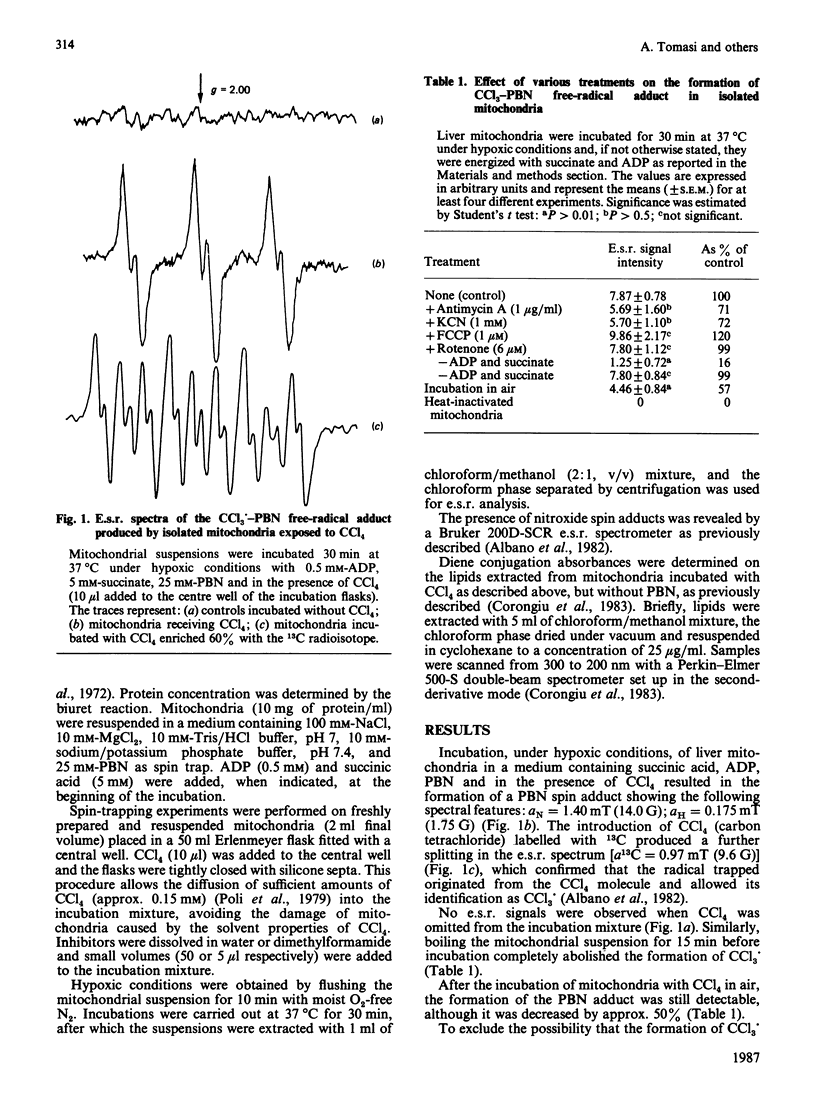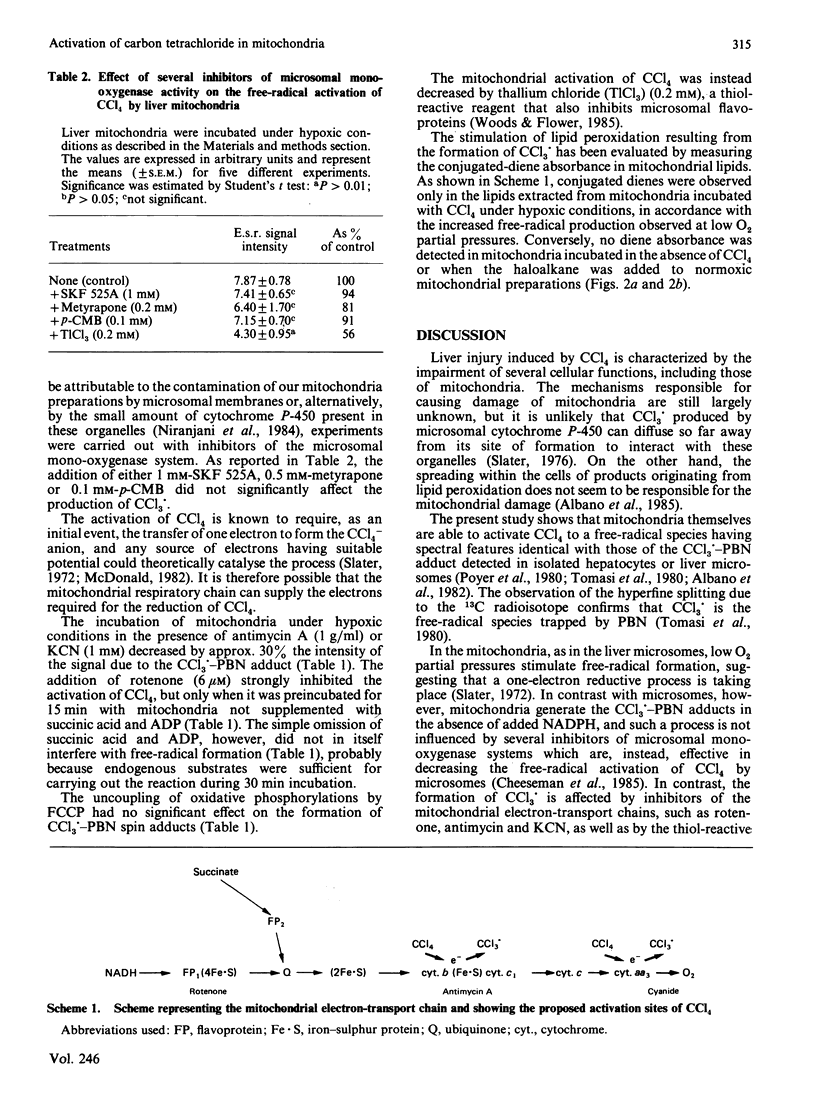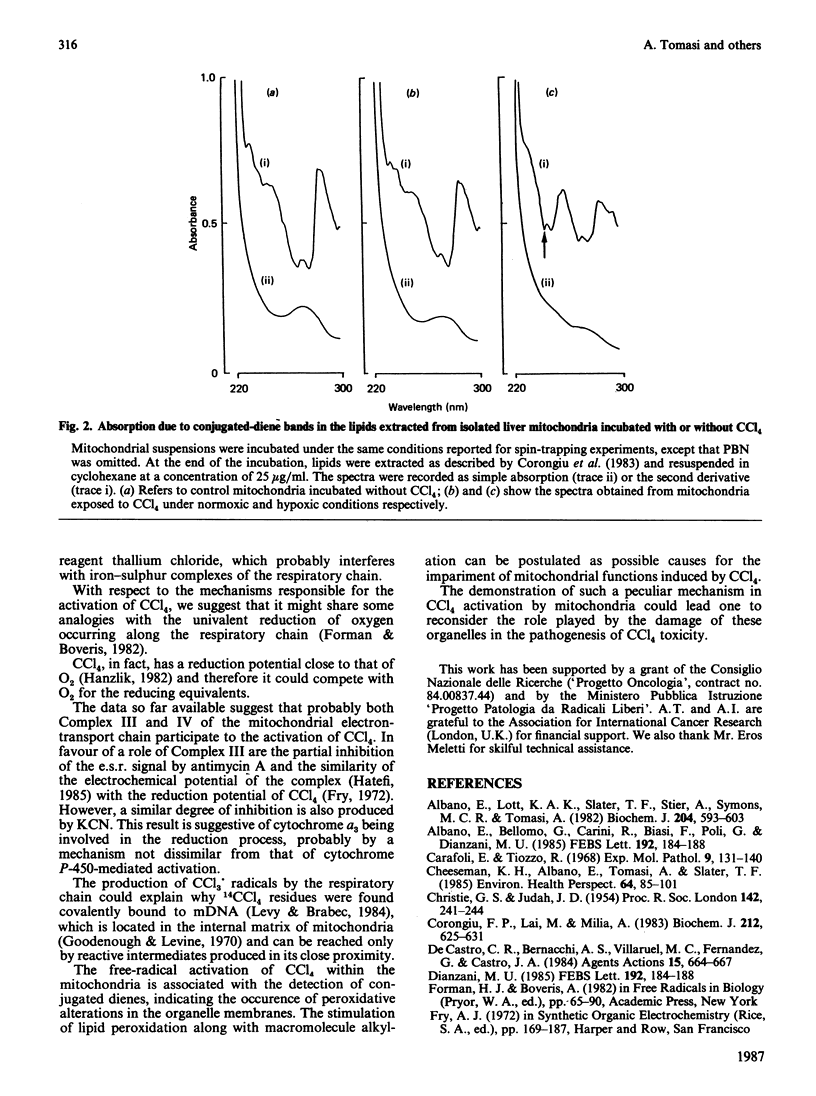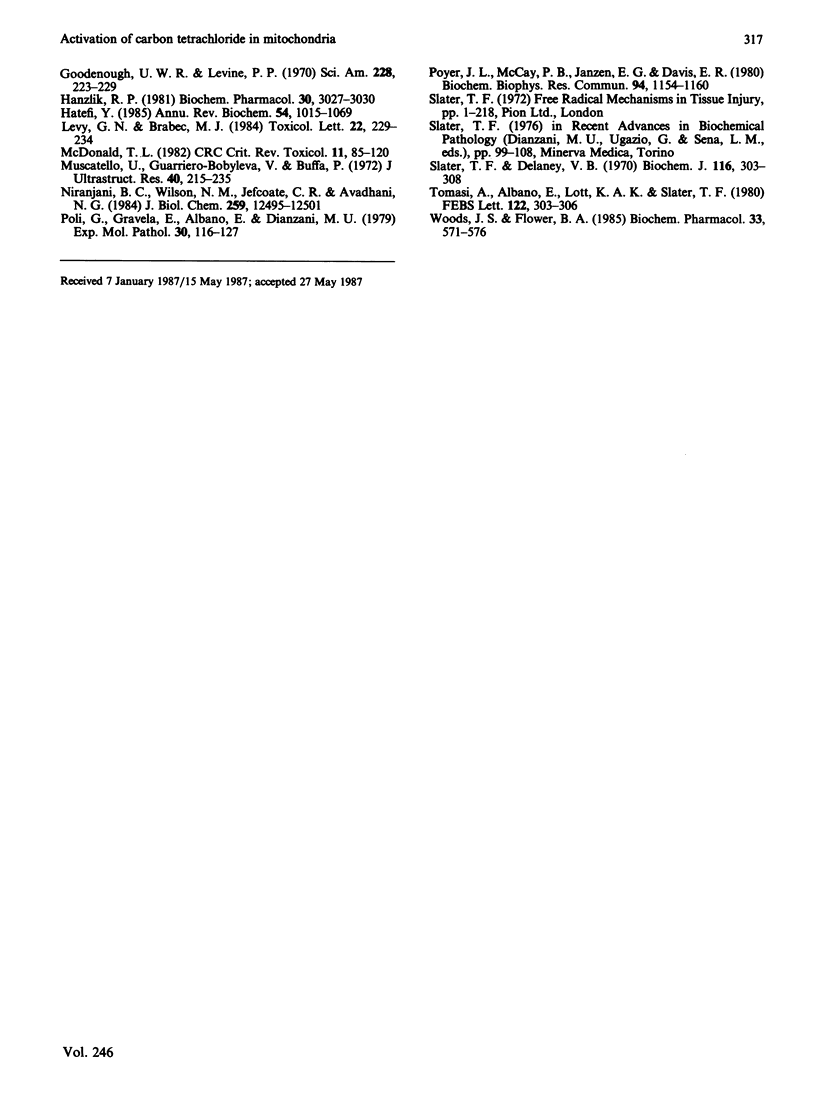Abstract
Alterations in liver mitochondria as consequence of rat poisoning with carbon tetrachloride (CCl4) have been reported over many years, but the mechanisms responsible for causing such damage are still largely unknown. Isolated rat liver mitochondria incubated under hypoxic conditions with succinate and ADP were found able to activate CCl4 to a free-radical species identified as trichloromethyl free radical (CCl3) by e.s.r. spectroscopy coupled with the spin-trapping technique. The incubation of mitochondria in air decreased free-radical production, indicating that a reductive reaction was involved in the activation of CCl4. However, in contrast with liver microsomes (microsomal fractions), mitochondria did not require the presence of NADPH, and the process was not significantly influenced by inhibitors of cytochrome P-450. The addition of inhibitors of the respiratory chain such as antimycin A and KCN decreased free-radical formation by only 30%, whereas rotenone displayed a greater effect (approx. 84% inhibition), but only when preincubated for 15 min with mitochondria not supplemented with succinate. These findings suggest that the mitochondrial electron-transport chain is responsible for the activation of CCl4. A conjugated-diene band was observed in the lipids extracted from mitochondria incubated with CCl4 under anaerobic conditions, indicating that stimulation of lipid peroxidation was occurring as a result of the formation of free-radical species.
Full text
PDF




Selected References
These references are in PubMed. This may not be the complete list of references from this article.
- Albano E., Bellomo G., Carini R., Biasi F., Poli G., Dianzani M. U. Mechanisms responsible for carbon tetrachloride-induced perturbation of mitochondrial calcium homeostasis. FEBS Lett. 1985 Nov 18;192(2):184–188. doi: 10.1016/0014-5793(85)80104-6. [DOI] [PubMed] [Google Scholar]
- Albano E., Bellomo G., Carini R., Biasi F., Poli G., Dianzani M. U. Mechanisms responsible for carbon tetrachloride-induced perturbation of mitochondrial calcium homeostasis. FEBS Lett. 1985 Nov 18;192(2):184–188. doi: 10.1016/0014-5793(85)80104-6. [DOI] [PubMed] [Google Scholar]
- Albano E., Lott K. A., Slater T. F., Stier A., Symons M. C., Tomasi A. Spin-trapping studies on the free-radical products formed by metabolic activation of carbon tetrachloride in rat liver microsomal fractions isolated hepatocytes and in vivo in the rat. Biochem J. 1982 May 15;204(2):593–603. doi: 10.1042/bj2040593. [DOI] [PMC free article] [PubMed] [Google Scholar]
- Carafoli E., Tiozzo R. A study of energy-linked calcium transport in liver mitochondria during CCl4 intoxication. Exp Mol Pathol. 1968 Aug;9(1):131–140. doi: 10.1016/0014-4800(68)90057-9. [DOI] [PubMed] [Google Scholar]
- Cheeseman K. H., Albano E. F., Tomasi A., Slater T. F. Biochemical studies on the metabolic activation of halogenated alkanes. Environ Health Perspect. 1985 Dec;64:85–101. doi: 10.1289/ehp.856485. [DOI] [PMC free article] [PubMed] [Google Scholar]
- Corongiu F. P., Lai M., Milia A. Carbon tetrachloride, bromotrichloromethane and ethanol acute intoxication. New chemical evidence for lipid peroxidation in rat tissue microsomes. Biochem J. 1983 Jun 15;212(3):625–631. doi: 10.1042/bj2120625. [DOI] [PMC free article] [PubMed] [Google Scholar]
- Hanzlik R. P. Reactivity and toxicity among halogenated methanes and related compounds. A physicochemical correlate with predictive value. Biochem Pharmacol. 1981 Nov 15;30(22):3027–3030. doi: 10.1016/0006-2952(81)90488-3. [DOI] [PubMed] [Google Scholar]
- Hatefi Y. The mitochondrial electron transport and oxidative phosphorylation system. Annu Rev Biochem. 1985;54:1015–1069. doi: 10.1146/annurev.bi.54.070185.005055. [DOI] [PubMed] [Google Scholar]
- Levy G. N., Brabec M. J. Binding of carbon tetrachloride metabolites to rat hepatic mitochondrial DNA. Toxicol Lett. 1984 Aug;22(2):229–234. doi: 10.1016/0378-4274(84)90071-7. [DOI] [PubMed] [Google Scholar]
- Muscatello U., Guarriera-Bobyleva V., Buffa P. Configurational changes in isolated rat liver mitochondria as revealed by negative staining. II. Modifications caused by changes in respiratory states. J Ultrastruct Res. 1972 Aug;40(3):235–260. doi: 10.1016/s0022-5320(72)90098-6. [DOI] [PubMed] [Google Scholar]
- Niranjan B. G., Wilson N. M., Jefcoate C. R., Avadhani N. G. Hepatic mitochondrial cytochrome P-450 system. Distinctive features of cytochrome P-450 involved in the activation of aflatoxin B1 and benzo(a)pyrene. J Biol Chem. 1984 Oct 25;259(20):12495–12501. [PubMed] [Google Scholar]
- Poli G., Gravela E., Albano E., Dianzani M. U. Studies on fatty liver with isolated hepatocytes. II. The action of carbon tetrachloride on lipid peroxidation, protein, and triglyceride synthesis and secretion. Exp Mol Pathol. 1979 Feb;30(1):116–127. doi: 10.1016/0014-4800(79)90086-8. [DOI] [PubMed] [Google Scholar]
- Poyer J. L., McCay P. B., Lai E. K., Janzen E. G., Davis E. R. Confirmation of assignment of the trichloromethyl radical spin adduct detected by spin trapping during 13C-carbon tetrachloride metabolism in vitro and in vivo. Biochem Biophys Res Commun. 1980 Jun 30;94(4):1154–1160. doi: 10.1016/0006-291x(80)90540-9. [DOI] [PubMed] [Google Scholar]
- Slater T. F., Delaney V. B. Liver adenosine triphosphate content and bile flow rate in the rat. Biochem J. 1970 Jan;116(2):303–308. doi: 10.1042/bj1160303. [DOI] [PMC free article] [PubMed] [Google Scholar]
- Tomasi A., Albano E., Lott K. A., Slater T. F. Spin trapping of free radical products of CC14 activation using pulse radiolysis and high energy radiation procedures. FEBS Lett. 1980 Dec 29;122(2):303–306. doi: 10.1016/0014-5793(80)80461-3. [DOI] [PubMed] [Google Scholar]
- Woods J. S., Fowler B. A., Eaton D. L. Studies on the mechanisms of thallium-mediated inhibition of hepatic mixed function oxidase activity. Correlation with inhibition of NADPH-cytochrome c (P-450) reductase. Biochem Pharmacol. 1984 Feb 15;33(4):571–576. doi: 10.1016/0006-2952(84)90309-5. [DOI] [PubMed] [Google Scholar]
- de Castro C. R., Bernacchi A. S., Villarruel M. C., Fernández G., Castro J. A. Carbon tetrachloride activation by highly purified liver mitochondrial preparations. Agents Actions. 1984 Dec;15(5-6):664–667. doi: 10.1007/BF01966789. [DOI] [PubMed] [Google Scholar]


